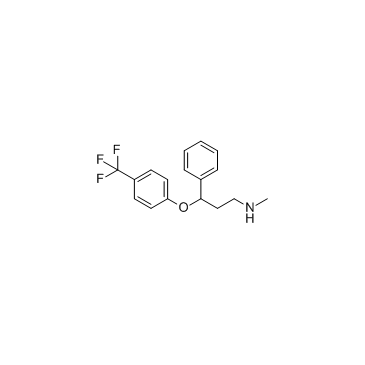Fluoxetine (LY-110140) |
| Catalog No.GC33715 |
Fluoxetine (LY-110140) is an orally active selective serotonin reuptake inhibitor (SSRI). Fluoxetine is a potent inhibitor of the saturated [3H]-5-HT uptake process in rat and human platelets, with IC50 values of 0.10 and 0.05 μM, respectively.
Products are for research use only. Not for human use. We do not sell to patients.

Cas No.: 54910-89-3
Sample solution is provided at 25 µL, 10mM.
Fluoxetine (LY-110140) is an orally active, selective serotonin reuptake inhibitor (SSRI) commonly used to treat a variety of psychiatric disorders such as depression, obsessive-compulsive disorder, and panic disorder. Fluoxetine is a potent inhibitor of the saturable [3H]-5-HT (serotonin) uptake process in rat and human platelets, with IC50 values of 0.10 and 0.05 μM, respectively[1]. It exerts its antidepressant effects by specifically inhibiting the reuptake of serotonin (5-HT) in the central nervous system, thereby increasing the concentration of 5-HT in the brain.
In vitro, Fluoxetine (LY-110140) inhibits the K+ currents in OK cells in a concentration-dependent manner, with an EC50 of 107 (84.8; 129.5) μM[2]. Fluoxetine (LY-110140) (5 mg/kg; for 21 days) increases the number of newborn cells in the dentate gyrus of the hippocampus in adult rats, as well as the number of proliferating cells in the prefrontal cortex[3].
In vivo, subchronic study of Fluoxetine (LY-110140) (10 mg/kg/day, orally) in adult male Wistar rats for 15 days significantly reduced urinary K+ excretion, indicating that fluoxetine has an inhibitory effect on renal epithelial K+ channels[2]. After Fluoxetine (LY-110140) treatment, the observed delay in escape latency in adult male Sprague-Dawley rats was reversed[4]. Furthermore, in SD rats, the combination of Fluoxetine (LY-110140) and olanzapine produced robust, sustained increases in extracellular levels of dopamine and norepinephrine, exceeding the baseline by 361% and 272%, respectively, an effect significantly greater than that of either drug used alone[5].
References:
[1] David T. Wong, Kenneth W. Perry, Frank P. Bymaster, et al. The Discovery of Fluoxetine Hydrochloride (Prozac)[J]. Nature Reviews Drug Discovery volume 4, pages764–774 (2005).
[2] Vieira-Coelho M A ,Fátima. Martel. Inhibition of kidney potassium channels by fluoxetine: In vivo and in vitro studies[J].Fundamental & clinical pharmacology, 2022.
[3] Kodama M, et al. Chronic olanzapine or fluoxetine administration increases cell proliferation in hippocampus and prefrontal cortex of adult rat. Biol Psychiatry. 2004 Oct 15;56(8):570-80.
[4] Malberg JE, et al. Cell proliferation in adult hippocampus is decreased by inescapable stress: reversal by fluoxetine treatment. Neuropsychopharmacology. 2003 Sep;28(9):1562-71.
[5] Zhang W, et al. Synergistic effects of olanzapine and other antipsychotic agents in combination with fluoxetine on norepinephrine and dopamine release in rat prefrontal cortex. Neuropsychopharmacology. 2000 Sep;23(3):250-62.
Average Rating: 5 (Based on Reviews and 22 reference(s) in Google Scholar.)
GLPBIO products are for RESEARCH USE ONLY. Please make sure your review or question is research based.
Required fields are marked with *




